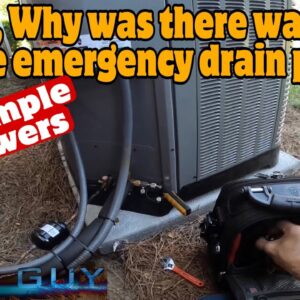Diagnosing and Fixing a Leaking AC Unit
Owners of air conditioning units often encounter issues with their equipment. Among the common problems is a full emergency drain pan. But there’s no need to worry. This article chronicles an AC technician’s job of diagnosing and fixing the problem.
Initial Check-Up and Diagnosis
The journey usually starts upon the owner’s notice of a problem. In the case of a full emergency drain pan, the technician usually waits for the owner before proceeding with the diagnosis. The reason this problem occurs may vary and are sometimes not straightforward. It may possibly be a clog, but in some cases, it could be something as mundane as the AC unit not being exactly level. Complexities arise when the owner is not around yet, like in one recent case I encountered.
As a technician, it is vital to maximize time while waiting for the owner. I initially attempted to vacuum out the water. However, I quickly realized that if a vent was involved, then these efforts would be rendered futile. I decided to wait until I could access inside the unit to identify the issue.
As part of the early diagnostic tools, it was necessary to check the switch to the water pan. When I did, I didn’t feel any obstruction that might indicate a clog. I switched it several times to see if the water level would differ. There was also an attempt at checking if the water level at the air handler was within the suggested range. However, there didn’t seem to be the exact problem; the AC unit may not exactly be at level.
Draining the Water and Adjusting Component Levels
Preparation Stage
After the initial examination, it was time to take further action. I wanted to empty the Ac unit of water and see how it’d fare. I brought up a small pump drill to drain all the water. Upon draining, there seemed to be no difference in the AC unit’s situation – the water in the pan did not decrease.
Given this observation, I decided to check the pressure of the AC unit. This is necessary as freezing can signify a problem. However, this was not the case. I then proceeded to check the level of the air handler. Following the checks, my suspicion was confirmed: the air handler was not entirely level.
During the Task
I took note that the air handler was slightly higher on one side than the other. I planned to lift it to balance the level but I realized that I had to find something to put under it to keep it stabilized. Fortunately, I noticed that the design of the air handler allowed me to lift it without having to get additional tools. Upon lifting, the level seemed very much improved.
Further Diagnoses and Solution
It was then time to inspect the kind of filter used. I noticed they have multiple filters for the AC unit. It appeared that they were well taken care of as they weren’t very dirty. I then had to confirm this by checking the static pressure. Through this test, I discovered that the static pressure was too much. This could lead to high velocity across the coil, resulting in water getting pulled off the coil.
Upon noting the high static pressure, I thought the solution would be to reduce the high speed from five down to three. While this reduced the static pressure, it did not seem enough. The return, in particular, was still high. I decided to leave it at that level to observe if there would be any changes.
The Final Check-Up and Conclusion
A day later, I returned to check the AC unit. To my disappointment, the problem remained the same. I felt more convinced that the problem was indeed the lack of exact level of the AC unit. To solve this, I jacked up the AC unit by inserting pads to allow it to drain easily. It was then that I noticed the water began to drain from the pan.
In conclusion, diagnosing and fixing an AC problem such as a full emergency drain pan requires thoroughness and patience. Owners should remember that in case of such, a technician must make sure that the AC unit is exactly level and any indications of high static pressure are managed.
Remember, your comfort is paramount, thanks for reading, and catch you in the next guide!

